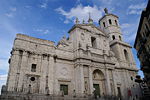Royal Palace of Valladolid
Bien de Interés Cultural landmarks in the Province of ValladolidBuildings and structures completed in 1528Palace stubsPalaces in ValladolidRenaissance architecture in Valladolid ... and 3 more
Royal residences in SpainSpanish building and structure stubsTourist attractions in Castile and León

The Royal Palace of Valladolid was the official residence of the Kings of Spain during the period in which the Royal Court had its seat in Valladolid between 1601 and 1606, and a temporary residence of the Spanish Monarchs from Charles I to Isabella II, as well as of Napoleon during the War of the Independence. Currently is the headquarters of the 4th General Sub-inspection of the Army.
Excerpt from the Wikipedia article Royal Palace of Valladolid (License: CC BY-SA 3.0, Authors, Images).Royal Palace of Valladolid
Plaza de San Pablo, Valladolid San Pablo - San Nicolás
Geographical coordinates (GPS) Address External links Nearby Places Show on map
Geographical coordinates (GPS)
| Latitude | Longitude |
|---|---|
| N 41.6564 ° | E -4.7258 ° |
Address
Palacio Real (Capitanía General)
Plaza de San Pablo
47003 Valladolid, San Pablo - San Nicolás
Castile and León, Spain
Open on Google Maps










